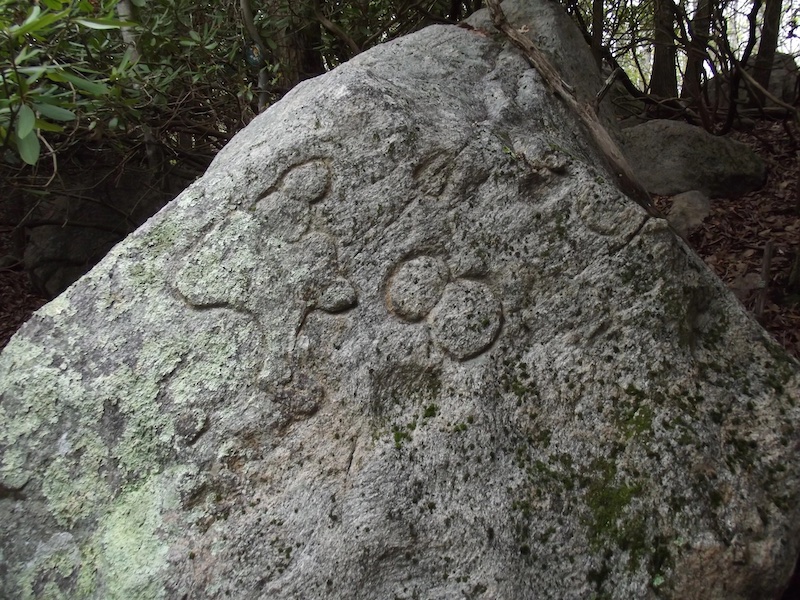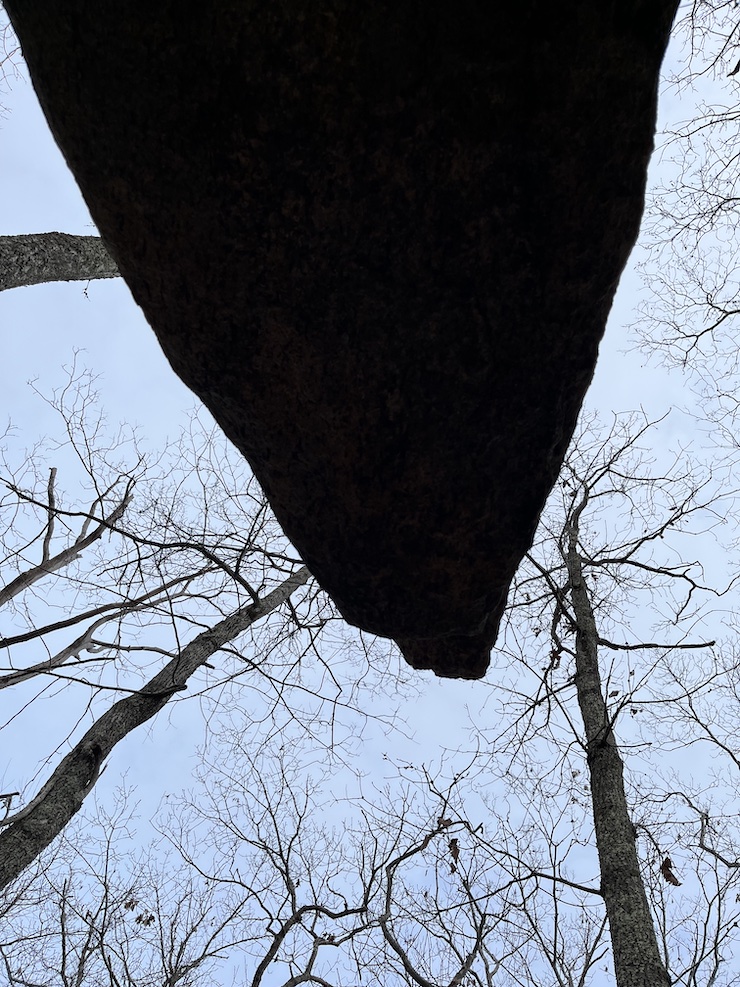I read the famous novel by Gabriel Garcia Marquez, One Hundred Years of Solitude. Wikipedia has this to say about the novel:
| Since he was 18, Garcia Marquez had wanted to write a novel based on his grandparents’ house where he grew up. However, he struggled with finding an appropriate tone and put off the idea until one day the answer hit him while driving his family to Acapulco. He turned the car around and the family returned home so he could begin writing. He sold his car so his family would have money to live on while he wrote. Writing the novel took far longer than he expected; he wrote every day for 18 months. His wife had to ask for food on credit from their butcher and baker as well as nine months of rent on credit from their landlord.
During the 18 months of writing, Garcia Marquez met with two couples... every night and discussed the progress of the novel, trying out different versions. When the book was published in 1967, it became his most commercially successful novel... selling over 50 million copies.... The story chronicles several generations of the Buendia family from the time they founded the fictional South American village of Macondo, through their trials and tribulations, and instances of incest, births, and deaths. The history of Macondo is often generalized by critics to represent rural towns throughout Latin America or at least near Garcia Marquez’s native Aracataca. |
Perhaps a Marquez scholar could tell us more about this “Acapulco moment,” this Eureka moment. What was the idea that brought the book together, that inspired Marquez to turn his car around, abandon his vacation plan, and start writing? In an earlier issue, I wrote, “After Dostoyevsky lost all his money in a German casino, the plot of Crime and Punishment came to him in a flash, a vision.” I wouldn’t say that Marquez’ Acapulco moment was a vision; I would call it an idea, a strategy. And I wouldn’t describe Marquez’ strategy as a plot because One Hundred Years doesn’t really have a plot; perhaps the term “plot device” would be more appropriate.
[Spoiler warning: If you’re thinking of reading Marquez’ novel, you might want to skip the rest of this section.]
So what was the plot device that prompted Marquez to turn his car around? Perhaps it was the device that appears at the end of the novel — the prophecies of the gypsy alchemist, Melquiades, prophecies which describe the whole history of the Buendia family, prophecies which are finally deciphered at the end of the novel by the last of the Buendias, who reads of his own demise as his life is ending. It’s a clever ending, but does it touch the reader? Does the reader care about these characters?
Marquez has a deep grasp of the occult, but he stretches the occult beyond truth, beyond credibility. Nobody can really believe that Melquiades prophesied the whole history of the Buendia family, or that the last Buendia was simultaneously reading the prophecy and living it. Marquez frequently refers to Nostradamus; Melquiades is a small-town Nostradamus. The prophecies of Nostradamus are a serious matter; Jung wrote a serious study of them.1 But with Marquez, prophecy becomes an amusement, a device. If you’re interested in the occult, as I am, you’ll find Marquez continually interesting, but continually disappointing.
In the last chapter of One Hundred Years, Marquez says that, in the prophecies of Melquiades, “Melquiades had not put events in the order of man’s conventional time, but had concentrated a century of daily episodes in such a way that they coexisted in one instant.” This is an interesting idea, especially if the reader is interested in the occult, but is it believable? Does it touch the reader? Marquez is overthrowing our everyday conception of time, he’s overthrowing linear time; he’s saying that the future exists already, and can be grasped by prophets like Nostradamus and Melquiades. All of this is interesting in an intellectual way, and it’s an amusing fantasy, but it doesn’t come out of the author’s own experience, and it doesn’t touch the reader’s heart.
In my Realms of Gold, I said that Thomas Wolfe anticipated his early death: “Something has spoken to me in the night,” Wolfe wrote, “burning the tapers of the waning year; something has spoken in the night, and told me I must die.... A wind is rising, and the rivers flow.” Here we have a prophecy that’s both touching and realistic, it comes out of the author’s heart, and it touches the reader’s heart. But the prophecies of Marquez seem like mere devices, wild fantasies.
Furthermore, the prophecies of Melquiades are written in a complicated code: “He had written it in Sanskrit, which was his mother tongue, and he had encoded the even lines in the private cipher of the Emperor Augustus and the odd ones in a Lacedemonian military code.” So instead of genuine prophecy, we have wild fantasy.
One day, four boys attempt to destroy the prophecies. “But as soon as they laid hands on the yellowed sheets an angelic force lifted them off the ground and held them suspended in the air until Aureliano returned and took the parchments away from them.” Again we have a wild fantasy, a story that lacks the ring of truth.
Marquez depicts twins who die at the same time. This is interesting to a student of the occult; twins are often “entangled,” they often have a telepathic bond. But dying at the same time? Why would a telepathic rapport lead twins to die at the same time? Again, Marquez is taking an occult notion and giving it a strange twist, he’s changing it from a deep truth to a wild fantasy. A more likely situation would be for one twin to die, and the other to sense this death; or for one twin to die, and the other to hear himself called, at the moment of death, by the dying twin.
When twins die at the same time, I’m reminded of Adams and Jefferson dying on July 4; Adams and Jefferson wanted to live until July 4; their will-to-live enabled them to reach the 4th. But Marquez’ twins have no such reason to die together.
Arthur Koestler died with his wife in a “suicide pact,” as did the Austrian writer Stefan Zweig, and the German writer Kleist.2 But with Marquez’ twins, there’s no such pact, no desire to die together. So the simultaneous death of Marquez’ twins doesn’t have the ring of truth.
Marquez plays with the idea of entangled twins, as he plays with many occult ideas. He carries the idea to an extreme, so it becomes absurd or humorous:
| Until the beginning of adolescence they were two synchronized machines. They would wake up at the same time, have the urge to go to the bathroom at the same time, suffer the same upsets in health, and they even dreamed about the same things.... Santa Sofia de la Piedad gave one of them a glass of lemonade and as soon as he tasted it the other one said that it needed sugar. |
As in his story “The Handsomest Drowned Man in the World,” Marquez plays with the idea that your name is your destiny (nomen est omen). Many of the male characters in One Hundred Years are named Aureliano or Jose Arcadio. Marquez says, “While the Aurelianos were withdrawn, but with lucid minds, the Jose Arcadios were impulsive and enterprising, but they were marked with a tragic sign.” Your name determines your personality, your destiny.
One of the basic truths of the occult is mind over matter. Matter is, in some sense, conscious and alive, and can therefore be influenced by mind, will. People can will themselves to live longer, or to die sooner, as we see in the case of Adams and Jefferson. Nietzsche had limited interest in the occult, but he did realize that the will plays a role in death; he said that the deaths of Socrates and Jesus were willed deaths, and he said, “One perishes by no one but oneself.”3
Marquez often deals with willed death. He says, “Buendias died without any illness.” When Amaranta Ursula is bleeding profusely, she tells her husband “not to worry because people like her were not made to die against their will.” It’s their own will that kills people, Marquez and Nietzsche say, not physical causes.
Ursula says that she’s “waiting for the rain to stop in order to die.” When it finally stops raining, “Ursula had to make a great effort to fulfill her promise to die when it cleared.” Here again, Marquez takes a classic occult situation — mind over matter, willed death — and gives it a twist. Usually a person wills to stay alive, as Adams and Jefferson willed to stay alive until July 4. Or they have a will to die, but this will is unconscious, or semi-conscious. But with Marquez, we have something new and different and strange: Ursula makes a “great effort” to die, but doesn’t commit suicide.
Why does Marquez give occult situations a strange twist? Perhaps because LatinAmerican literature is saturated with the occult, so the occult became boring, and needed a dash of spice, a new twist. When I discussed a Brazilian novel, The Alchemist, I noted the many occult themes. When I discussed Marquez’ “The Handsomest Drowned Man in the World,” I noted the many occult themes. And when I discussed a story by Borges called “The Meeting,” I said that it had “a whiff of the occult.” So perhaps Marquez thought that the occult was old and stale, and needed a twist.
Another possibility is that Marquez was influenced by Borges, who stretches the occult into wild fantasy. In an earlier issue, I wrote,
| Borges seems to regard the occult not as real, but as something that can add spice to a fictional work. The occult element in this story [i.e., in “The Meeting”] (knives with a vendetta against each other) is unreal, unconvincing, false. Many great literary works deal with the occult and stay within the boundaries of truth — for example, Lawrence’s “The Fox” — but Borges goes beyond these boundaries. Perhaps this makes Borges popular with critics and academics — people who are interested in art, in craft, not in truth, not in reality. Great literature speaks to your own experience, and grabs you by the throat. But “The Meeting” doesn’t speak to anyone’s experience, it’s just a story; it shouldn’t be called magical realism, it should be called unreal magic. |
So perhaps Marquez wasn’t bored with the occult, but rather he felt that the occult should be blended with wild fantasy, because his mentor (Borges) had written this way.
The paterfamilias of the Buendia clan is Jose Arcadio Buendia, a giant man who goes mad and is tied to a tree. When his wife, Ursula, decides to move him to his bedroom, “Not only was he as heavy as ever, but during his prolonged stay under the chestnut tree he had developed the faculty of being able to increase his weight at will, to such a degree that seven men were unable to lift him and they had to drag him to the bed.” Here we have another example of mind over matter; the will can make one heavier. This idea isn’t as wild as it might seem; I’ve seen karate experts appear to make themselves heavier to avoid being lifted.
In a recent issue, I discussed the character of the “holy fool,” the “dummling” with deep wisdom. Marquez’ novel has a holy fool named Remedios the Beauty.
| She reached twenty without knowing how to read or write, unable to use the silver at the table, wandering naked through the house because her nature rejected all manner of convention.... It seemed as if some penetrating lucidity permitted her to see the reality of things beyond any formalism. |
When Fernanda sees Remedios the Beauty “eating with her hands, incapable of giving an answer that was not a miracle of simplemindedness,” she thinks Remedios the Beauty is an idiot. But the Colonel takes a different view; he thought “Remedios the Beauty was in no way mentally retarded, as was generally believed, but quite the opposite.” The Colonel says, “It’s as if she’s come back from twenty years of war.” War enables one to penetrate “beyond any formalism” to the “reality of things.” The Colonel and Remedios the Beauty have both gone beyond conventions and formalities. The Colonel is disillusioned, Remedios the Beauty is naive, a holy fool.
So Marquez is capable of creating interesting characters, but he doesn’t seem to create a fictional world that you can believe in, a fictional world that makes you “suspend your disbelief.” You don’t feel that his characters are real people, that his novel is a real world.
When the Colonel is captured and sentenced to death, he’s surprised to find that he has no premonition of death. The Colonel is a prophet, and he trusts his premonitions. “Since the beginning of adolescence, when he had begun to be aware of his premonitions, he thought that death would be announced with a definite, unequivocal, irrevocable signal, but there were only a few hours left before he would die and the signal had not come.”
Why doesn’t the signal come? Because he isn’t going to die; his executioners don’t dare to kill him, they’re afraid that the townspeople will rise up against them. Marquez has a deep grasp of the occult; Marquez realizes that premonitions can foretell the future, and the lack of a premonition can also foretell the future.4
As a stylist, Marquez is impressive, even when read in translation. His work holds your attention; it has clarity, force, life. But do his characters come alive? Can the reader empathize with these characters? Proust’s narrator comes alive because he’s Proust himself — his loves, his losses, his dreams. Each of the Karamazov brothers represents a facet of Dostoyevsky himself, and each of them comes to life. Hamlet has often been said to reflect Shakespeare himself. But Marquez’ characters don’t represent Marquez; it’s difficult to believe in these characters. They remain at “arm’s length” for the author, and for the reader.
When one of the Buendia boys asks his brother what sex feels like, the answer is, “It’s like an earthquake.” This is great writing: it’s a poetic image, it’s a description, it’s a witticism, and it’s very concise. Marquez is a first-rate stylist. But the earthquake metaphor isn’t enough to draw the reader into this fictional world. Sex plays an important role in Marquez’ novel, but it’s never beautiful or touching. One Hundred Years doesn’t have plot or suspense; it has great writing, and an abundance of ideas, an abundance of occult situations.
Marquez has a firm grasp of politics and war, at least in the context of Latin America. He probably knew many people who had experienced war, and he may have experienced war himself. One of the Buendias, Colonel Aureliano Buendia, fights a long war against the Conservative forces. After many years of fighting, the Colonel says to a comrade,
| “Tell me something, old friend: why are you fighting?” “What other reason could there be?” [the comrade] answered. “For the great Liberal party.” “You’re lucky because you know why,” [the Colonel] answered. “As far as I’m concerned, I’ve come to realize only just now that I’m fighting because of pride.” “That’s bad.” |
Perhaps wars are often fought from pride, to avoid humiliation. The original cause of war is forgotten, but the war goes on, it has a momentum of its own, neither side wants to admit defeat, both sides want power for the sake of power.
Both sides commit atrocities. War takes a toll on the conscience, the soul. When the Colonel has a widow’s house reduced to ashes, his comrade says, “Watch out for your heart, Aureliano.... You’re rotting alive.”
Finally the Colonel decides to stop fighting, and says to his comrade,
| “Put on your shoes and help me get this shitty war over with.” When he said it he did not know that it was easier to start a war than to end one. It took him almost a year of fierce and bloody effort to force the government to propose conditions of peace favorable to the rebels and another year to convince his own partisans of the convenience of accepting them. |
At the end of the war, the Colonel is utterly disillusioned, with no hopes or dreams, no notion of glory. He keeps busy by making metal fish, he tries to numb his mind, so “there was not the smallest empty moment left for him to fill with his disillusionment of the war.”
Marquez seems to be angry at the foreigners (Americans?) who come to Macondo to profit from the banana business. But the people suffer as much from civil wars as from the foreigners.
A critic named Linda B. Hall wrote an essay on Marquez’ novel; she called her essay “Labyrinthine Solitude,” a reference to the title of Marquez’ novel and to the title of a book by Octavio Paz, The Labyrinth of Solitude. Paz was about 15 years older than Marquez, and his Labyrinth of Solitude was published about 15 years before One Hundred Years of Solitude. In her essay, Hall says that modernity has made Latin Americans solitary. Traditional society was “peaceful, static, rural,” while modernity means “the throwing of the individual, alone and unaided, onto the urban labor market.” Hall quotes Paz, who says that modern solitude doesn’t strengthen the soul, it’s “utter damnation... the random solitude of hotels, offices, shops and movie theaters.”
But Marquez’ characters are in a small town, not in the “urban labor market.” I’m not convinced that Marquez has depicted modern solitude, though I accept the argument that he was influenced by Paz. The solitude in Marquez’ novel is often strange and unreal, as when a dead man (Prudencio Aguilar) seeks the company of the living. Another dead man, Melquiades, “had been through death, but he had returned because he could not bear the solitude.”
According to Paz, “death and birth are the two extreme solitary experiences.”5 People want to die with someone else, as in the suicide pacts that I mentioned above. As for the state of death, I don’t think we know whether there’s life after death, what sort of life it is, and whether it involves the feeling of loneliness.
Hall says that, for Paz and Marquez, “the deepest form of communion and the closest antidote to solitude is sexual love.... The act of love is a combination of the forces of creation and destruction that furnishes to man, for a fraction of a second, a ‘more perfect state of being.’” This strikes me as a valid point, but does Marquez embody this in his novel? For example, the young man who describes sex as an earthquake — is he seeking communion, or is he seeking pleasure and experience? And the older woman, Pilar Ternera, has sex with various men, but I don’t think she’s seeking an “antidote to solitude.”
Isaak Babel said of Nabokov, “He can write, but he’s got nothing to say.” This is how I feel about Marquez. What is Marquez trying to say? He’s a brilliant stylist, and he has an astonishing grasp of occult situations, but he doesn’t take the occult seriously, he twists it into wild fantasy. He doesn’t try to reach truth, or provide a reason for hope.
Paz wrote a play called Rappaccini’s Daughter, based on Hawthorne’s story of the same name. Hawthorne’s story has various “magical” elements; like Marquez’ novel, Hawthorne’s story has a beautiful woman who can kill with her breath. Was Hawthorne popular with writers like Paz, Borges, and Marquez? Did the magical elements in Hawthorne appeal to the “magical realists”?
The Hawthorne story is regarded as one of his best, and I thoroughly enjoyed it. It has plot and suspense; it bends reality, but doesn’t break it. I also enjoy “magical” writers like Gogol, Poe, and Kafka, and I enjoyed Marquez’ “Handsomest Drowned Man in the World.” But somehow I wasn’t drawn into Borges’ “Meeting” or Marquez’ One Hundred Years.
Hawthorne is even more preoccupied with solitude than Paz and Marquez. In an earlier issue, I argued that solitude is an important theme in all of Hawthorne’s work. In “Rappaccini’s Daughter,” the three main characters are all solitary.
Hawthorne himself was solitary, and he felt that his solitude was a curse. Emerson felt that Hawthorne died from his “painful solitude”; like the Buendias, Hawthorne didn’t die from an illness. Perhaps Hawthorne depicted solitude in a more realistic way than Marquez because Hawthorne drew on his own life.
Since “Rappaccini’s Daughter” is an important work by an important writer, there’s an abundance of criticism about it — an abundance of older criticism, which I prefer to modern criticism. I chose an essay called “Rappaccini’s Garden” (1958) by Charles Boewe. Boewe says that the theme of the story is the evil of racial mixing — among people and plants. We don’t know who Beatrice Rappaccini’s mother is, we only know that her father is Dr. Rappaccini, but we can surmise that Beatrice was the fruit of some sort of adulterous or improper union. Hawthorne says that the garden has been the scene of “such commixture, and, as it were, adultery, of various vegetable species, that the production was no longer of God’s making, but the monstrous offspring of man’s depraved fancy.”
Boewe points out that “the word ‘hybrid’ originally meant an insult or outrage, especially an outrage connected with sex. The Bible enjoins against hybridization: ‘Thou shalt not let thy cattle gender with a diverse kind: thou shalt not sow thy field with mingled seed: neither shall a garment mingled of linen and woolen come upon thee.’” Hybrids are accursed, hence they’re often infertile — mules, for example, are infertile.
[Spoiler warning: If you’re thinking of reading Hawthorne’s story, you might want to skip the rest of this section.]
According to Boewe, Beatrice must die at the end of the story. Hawthorne calls Beatrice “the poor victim of man’s ingenuity.” Boewe says that Beatrice is “doomed to barren extinction. Like her emblem, the hybrid flowers, she is a living violation of the static order of nature. However much we may pity her as a person, nature imperatively demands that she be purged from the system of created things.”
Boewe calls the reader’s attention to the Italian critic Mario Praz, who’s known for The Romantic Agony; Boewe says that Beatrice is one of Praz’ “decadent ladies,” Beatrice is “literally a femme fatale,” like Remedios the Beauty.
I also read a Hawthorne story called “My Kinsman, Major Molineux.” Again, the plot holds your attention, you want to know how it’s going to end. It’s about a young man from the country, Robin, who comes to Boston in search of his kinsman, Major Molineux. Robin has walked a long way, and reaches Boston as night is falling. Robin is unschooled in the ways of the world, and has too much confidence in himself, his wooden club, and his connection to the Major. Robin suffers a series of bumps and bruises; he’s mocked and threatened as he wanders around the city, looking for his kinsman.
One critic, Seymour Gross, says that Robin endures a “dark night of the soul,” an introduction to the dark side of human nature. Hawthorne has written a coming-of-age story. By the end of the story, Robin is lonely and afraid, he’d like to return to the comfort of his parents’ house. For Robin, solitude isn’t a curse, as it often is in Hawthorne; for Robin, solitude is a learning experience, part of the process of growing up and leaving home.
Robin finally encounters his kinsman, Major Molineux, but the major can’t help him; the major is an official in the British government, and he’s been tarred and feathered by an anti-British mob.6 Gross argues that Hawthorne often deals with history, but history is merely a setting for Hawthorne; Hawthorne’s chief focus is on the moral, the psychological. Robin meets one sympathetic man, who urges him not to flee from Boston too hastily.
Gross argues that “My Kinsman, Major Molineux” is one of Hawthorne’s best stories, though it’s an early story, written in 1831, when Hawthorne was just 27. “In this tale,” Gross writes, “the literal drama is the symbolic drama.” In later stories, Hawthorne catered to public taste, and separated “action and idea,” so that “the moral [would be] plain and manifest.”
Heine may have been the first to foresee genocide in Germany, but he didn’t realize that this genocide would target Jews. In 1834, Heine wrote,
|
Christianity — and this is its greatest merit — has somewhat mitigated the brutal German love of war, but it could not destroy it. Should that subduing talisman, the cross, be shattered, the frenzied madness of the ancient warriors, that insane Berserk rage of which the Nordic bards have spoken and sung so often, will once more burst into flame. This talisman is fragile. And the day will come when it will collapse miserably. Then the ancient stony gods will rise from the forgotten debris and rub the dust of a thousand years from their eyes. And then Thor, with his giant hammer, will jump up and smash the Gothic cathedrals.
Do not smile at my advice, the advice of a dreamer who warns you against Kantians, Fichteans, and philosophers of nature. Do not smile at the visionary who anticipates the same revolution in the realm of the visible that has already taken place in the realm of the spirit. Thought precedes action, as lightning precedes thunder. German thunder is of true Teutonic character. It is not nimble, but rumbles ponderously. Yet it will come. And when you hear a crashing such as never before has been heard in the history of the world, then you will know that the German thunderbolt has fallen. At that uproar, the eagles of the air will drop dead. The lions in the remotest deserts of Africa will hide in their royal dens. A play will be performed in Germany which will make the French Revolution look like an innocent idyll.7 |
Nietzsche, writing 40 or 50 years after Heine, not only foresaw genocide in Germany, but also foresaw that it would target Jews. Nietzsche wrote,
| The whole problem of the Jews exists only within national states, inasmuch as their energy and higher intelligence, their capital of spirit and will, which accumulated from generation to generation in the long school of their suffering, must predominate to a degree that awakens envy and hatred; and so, in the literature of nearly all present-day nations (and, in fact, in proportion to their renewed nationalistic behavior), there is an increase in the literary misconduct that leads the Jews to the slaughterhouse, as scapegoats for every possible public and private misfortune. As soon as it is no longer a matter of preserving nations, but rather of producing the strongest possible mixed European race, the Jew becomes as useful and desirable an ingredient as any other national quantity.8 |
In 1881, Nietzsche said that the next century would witness
| the decision as to the destiny of the Jews of Europe. That their die is cast, that they have crossed their Rubicon, is now palpably obvious: all that is left for them is either to become the masters of Europe or to lose Europe as they once a long time ago lost Egypt. [In Europe] they have gone through an eighteen-century schooling such as no other nation of this continent can boast of — and what they have experienced in this terrible time of schooling has benefited the individual to a greater degree than it has the community as a whole. As a consequence of this, the psychological and spiritual resources of the Jews today are extraordinary; of all those who live in Europe they are least liable to resort to drink or suicide in order to escape from some profound dilemma — something the less gifted are often apt to do.9 |
In another passage, Nietzsche speaks of a statesman who resembles Hitler, a statesman who “piles up for [the people] another tower of Babel, a monster of empire and power.” Doubtless this statesman is ruling Germany (the translator, Walter Kaufmann, says in a footnote, “without a doubt, Germany”). Nietzsche says that this statesman “goaded the slumbering passions and lusts of his people.” This statesman was one “for whom his people would have to atone for all future time, if they have any future.”10
Kaufmann is sure that Nietzsche’s statesman is Bismarck, I’m sure that Nietzsche is anticipating Hitler. Germany doesn’t need to “atone” for Bismarck, it needs to atone for Hitler. Bismarck didn’t put a cloud over Germany’s future, Hitler did. Nietzsche foresaw many of the developments of the 20th century, Nietzsche had the capacity to foresee Hitler.
Nietzsche admired Caesar and Napoleon, but he didn’t see the “Hitler figure” in the same way. He calls the Hitler figure, “Strong and insane! Not great!”11
In another passage, Nietzsche imagines a foreigner traveling in Germany, commenting on various things:
| The future of the Germans he found threatened and threatening: for they had forgotten how to enjoy themselves (which the Italians understand so well) but through the great game of chance of wars and dynastic revolutions became accustomed to emotion, consequently they would one day have an uprising. For this was the strongest emotion a people could procure for itself.... The German socialist was the most dangerous... a very plebeian Faust. “For Bismarck has driven out of the cultivated Germans the Faust Devil that plagued them so,” he cried in conclusion: “but now the Devil has entered into the swine and is worse than ever he was!”12 |
In the above passage, Nietzsche seems to foresee the emotional character of the Nazi movement — Hitler’s impassioned speeches, the mass rallies, the excited crowds. Nietzsche also foresees that the Nazi movement would be a working-class movement, not unlike the socialist movement; the Nazi movement was “National Socialism.”
In another passage, Nietzsche says, “I have not met a German yet who was well disposed toward the Jews.” Germans say,
| “Admit no more new Jews! And especially close the doors to the east!” ....Thus commands the instinct of a people whose type is still weak and indefinite, so it could easily be blurred or extinguished by a stronger race. The Jews, however, are beyond any doubt the strongest, toughest, and purest race now living in Europe.13 |
In his autobiography Ecce Homo, Nietzsche wrote,
| I know my fate. One day my name will be associated with the memory of something tremendous — a crisis without equal on earth, the most profound collision of conscience, a decision that was conjured up against everything that had been believed, demanded, hallowed so far.... There will be wars the like of which have never yet been seen on earth. It is only beginning with me that the earth knows great politics.14 |
In my view, the above passage anticipates the Holocaust and the world wars. It also anticipates how Nietzsche’s name will be “associated with the memory” of the Nazis, despite the fact that he was critical of anti-Semitism, especially German anti-Semitism; he even suggested expelling anti-Semites from Germany.15
If we consider all these passages, I think it’s clear that Nietzsche foresaw the Holocaust, though none of these passages, taken by itself, is an unequivocal prediction of the Holocaust. Nietzsche foresaw German history so clearly that, if he had written nothing but the above passages, he would be considered a deep thinker, a prescient thinker.16
If Nietzsche was critical of anti-Semitism, why was his name associated with the Nazis? As we saw above, Heine believed that Christianity restrained the Germans. Nietzsche was Christianity’s toughest critic; he even criticized Christian morality, which many atheists respected. So it can be argued that Nietzsche helped to unleash the Germans’ “love of war,” their “Berserk rage.”
Here in New England, NativeAmericans made various kinds of stone structures. Those who study these structures say that, if you travel to the American Southwest, you find many of the same kinds of structures; these structures aren’t unique to New England. Below is a grinding stone that I saw at Nobscot Hill in Framingham, Massachusetts (click here for more info and a map).

The grinding stone probably weighs at least 1,000 pounds, so it’s a solid work surface. The “bowl” is at the right height for working — a person of average height doesn’t need to reach up, or lean down. Doubtless there are many grinding stones scattered around. Some, like this one, are well known and mentioned on various websites; others are probably yet to be found. A grinding stone is a large tool; its purpose is obvious, and few would deny that it was made by Native Americans. Other Indian stones are more ambiguous, more “religious,” and more controversial.
The word “Nobscot” is a short form of “Penobscot,” which is a NativeAmerican word for “Place of the Falling Rock.” Nobscot Hill is one of the more significant hills in Boston’s western suburbs. Thoreau was familiar with Nobscot Hill, and mentions it several times in his Journals. Nowadays it can be identified by its numerous towers; it has a fire tower, a radio tower, etc. The view from the summit is obscured by trees; you’ll get a better view if the ranger is willing to let you climb the fire tower.
Another type of Indian stone structure is the Standing Stone; the one below is in Smithfield, Rhode Island (click here for more info and a map).

A Standing Stone has no practical purpose; it’s not a tool, it might be called a combination of religion and art.
A third kind of structure is the Balanced Rock. The one below is near Mt. Wachusett, in central Massachusetts (trail map here).

This Balanced Rock is unusual for its large size; usually the “under rock” is much smaller than the “top rock.” In the picture above, notice that the top rock points upward; Native Americans liked rocks that point upward (the Standing Stone shown above has that upward-pointing shape). Skeptics, who question whether Native Americans made stone structures, will say that the Balanced Rock shown above was created by glaciers, created by chance; but the odds of the top rock coming to rest securely on the bottom rock are very small.
Or skeptics will say that, if it was created by man, we can’t tell whether it was created by Native Americans or white settlers. It’s very unlikely that white settlers would take the trouble to build something that, in their minds, had no practical or religious or artistic purpose. White settlers viewed rocks in a practical way, they didn’t view them as religion/art; insofar as white settlers were religious, their religion didn’t involve Standing Stones, Balanced Rocks, etc.
Tippling Rock, near Nobscot Hill, was probably a Balanced Rock, but it made the local white farmer nervous, so it was split. “Tippling Rock” is now the name of a hilltop (and the trail to the hilltop); this hilltop offers good views, and broad ledges for picnics. On the ledges is the split rock that was once (in my view) a Balanced Rock.
Below is another Balanced Rock. The under rock is much smaller than the top rock; after being propped-up, the top rock has an upward-pointing shape (info here).

Another kind of structure made by Native Americans are Solstice Stones — stones that align with the sun at the winter solstice, or align with some other celestial event. Below are Solstice Stones (map here); I’ve put a V on the opening through which the sun comes (at sunrise on the winter solstice), and I’ve put a circle on a chunk of quartz (Native Americans had a special fondness for quartz).

Solstice Stones have no practical purpose; I think of them as a combination of science, religion, and art. Solstice Stones are one of the strongest arguments in support of the view that Native Americans made stone structures; in other words, they present a difficult problem for skeptics.
Another kind of Indian stone structure is the stone mound (sometimes called a stone pile or a cairn). Below is a rather small stone pile (info here):

Stone piles are often found in groups. They’re made up of stones of similar size (usually medium size). Some people think they were built to commemorate the dead — a kind of gravestone. On the other hand, they’re often built on top of rock outcrops, making burial impossible. So it’s difficult to say what their purpose was.
Below is an unusually large stone mound (info here):

Sometimes a stone pile can be arranged to resemble an animal, usually a turtle or snake. Below is a turtle effigy (the turtle’s head is on the right, more info here):

Below is a large snake head, part of a large snake effigy (info here):

Another kind of Indian structure is the “stone row” (picture below, info here). Stone rows made by Native Americans resemble stone walls made by white settlers.

What distinguishes a stone row is that it often ends abruptly — it doesn’t go anywhere, or serve any purpose. Another characteristic of a stone row is that the stones often stand on end, instead of lying flat. A third characteristic of a stone row is that it often ends with a special arrangement of stones, a terminal arrangement. A fourth characteristic is that stone rows are usually short — shorter than stone walls made by settlers. A fifth characteristic is that, in a native stone row, the stones are often carefully balanced. One wonders, “How come that doesn’t fall down?” Below is a picture of balancing stones within a stone row (info here). Notice that the top rock (or top structure) has the upward-pointing shape that natives were so fond of.

Yet another characteristic of a stone row is that it has “manitou stones,” that is, upward-pointing stones that have a head-and-shoulders shape. Below is a manitou stone; notice how it stands on end, and notice how it’s next to the stone row, not on it (map here).

Below is another “adjacent manitou,” i.e., an upward-pointing stone placed next to a stone row, adjacent to a stone row:

Stone rows often terminate in horizontal manitou stones, i.e., manitou stones that point, not upwards, but toward the end of the row.
Another characteristic of stone rows is that they have openings, perforations, while white settlers tried to build walls that were solid. Below is an example of a stone row with an opening:

photo by Walter van Roggen
Below is another stone row with an opening:

Below is yet another opening in a stone row:

Below is another “adjacent manitou,” i.e., an upward-pointing stone placed next to a stone row, adjacent to a stone row:

Yet another characteristic of a stone row is that it’s often built near water — near a stream, pond, or swamp; Indians had a special interest in water. Stone rows often enclose a group of stone piles, forming what some believe is a graveyard.
Despite all the distinguishing characteristics of a stone row, it’s often difficult to say what’s a stone row (made by Native Americans), and what’s a stone wall (made by whites); skeptics will say that they’re all built by whites. Some stone rows may have been “adopted” and modified by whites; conversely, some stone walls may have been adorned/modified by natives.
In their study of NativeAmerican stones, Dix and Mavor often cite the writings of early settlers, who observed the natives, native religion, and native structures. Did early settlers note that stone rows had been built by natives, that stone rows existed prior to white settlement?
Another kind of structure is the stone enclosure, which is sometimes a small circle, and sometimes has a spiral shape, as in the picture below (info here).

Did such stone enclosures have a particular function? Were they for meditation, vision quest? Group activity?
I had heard that Native Americans had a special interest in cleft rocks, and often put smaller rocks into the cleft. I saw an example of this near Ashville Pond in Hopkinton, Rhode Island. (See picture below; for info/map, click here.)

Another kind of NativeAmerican stone is the petroglyph — images carved into a boulder. As with other NativeAmerican stones, petroglyphs may have been made by white settlers or white explorers. Click here for info/map about petroglyphs in Hopkinton, Rhode Island, petroglyphs that I believe were made by Native Americans. Below is one of the Hopkinton petroglyphs (photo from Strange New England)

I should also mention stone chambers (picture below, info here), which may have been built for solitude and vision quest.

Photo from StoneStructures.org
Stone chambers are an interesting type of structure, but can we be certain they were made by Indians? There’s much debate about the chamber pictured above. StoneStructures mentions matching stones in the chamber, and in an enclosure near the chamber. Matching stones, stones aligned with a solstice, or stones with conspicuous quartz, would argue for native origin, non-utilitarian origin.
Some stone structures don’t fit into any of these categories; they’re unique, creative. Below is a structure that I call The Diving Board (info and map here):

Here’s the Diving Board from below:

Below is a series of flat stones lying flat on the ground. It’s about 8 feet long and 20 inches wide. Lots of native work nearby.

Was someone buried here? The stones placed to prevent animals from digging? I can’t imagine that this was made by nature, and I can’t see why white settlers would have made this, so I think there’s a high probability it’s native-made.
When I posted this picture on a Facebook group, two people said they had seen similar structures, sometimes one by itself, sometimes several. One person in the Facebook group called it a “wolf stone,” placed over a buried body to prevent wolves from digging up the body. He said that a wolf stone was sometimes between a headstone and a footstone, but this is probably a pattern among white settlers, not natives.
Another kind of structure that Native Americans built is the earthen mound or berm; these earthen structures are often straight, sometimes round. Earthen mounds are often one foot or less in height, and difficult to photograph. Map of earthen mound here.
© L. James Hammond 2023
feedback
visit Phlit home page
become a patron via Patreon
make a donation via PayPal
| Footnotes | |
| 1. | See Ch. 7 of Jung’s Aion. Aion is Volume 9 in Jung’s Collected Works — more specifically, Volume 9, Part 2. back |
| 2. | In Kleist’s case, the woman was a close friend, not a spouse. back |
| 3. | Twilight of the Idols, “Expeditions of an Untimely Man,” #36. On Socrates and Jesus, see Nietzsche’s Assorted Opinions and Maxims, #94 (this book is part of the second volume of Nietzsche’s Human, All-Too-Human). See also Nietzsche’s Twilight of the Idols, “The Problem of Socrates,” #12 back |
| 4. | D. H. Lawrence also realized that the lack of a premonition is significant. He writes, “On the Sunday afternoon he went to Keston to meet Clara at the station. As he stood on the platform he was trying to examine in himself if he had a premonition. ‘Do I feel as if she’d come?’ he said to himself, and he tried to find out. His heart felt queer and contracted. That seemed like foreboding. Then he had a foreboding she would not come!” back |
| 5. | This is a quote from Hall, not Paz. back |
| 6. | One might describe Major Molineux as the victim of a charivari. I discussed the charivari in a recent issue, describing it as a “folk custom designed to shame a member of the community.” back |
| 7. | Heine, “Religion and Philosophy in Germany” (Project Gutenberg’s version here, I’m quoting a different translation) back |
| 8. | Human, All-Too-Human, #475 back |
| 9. | The Dawn, #205, translated by R. J. Hollingdale, Cambridge University Press, 1982 back |
| 10. | Beyond Good and Evil, #241 back |
| 11. | Beyond Good and Evil, #241 back |
| 12. | Assorted Opinions and Maxims, #324, translated by R. J. Hollingdale, Cambridge University Press, published inside Human, All-Too-Human back |
| 13. | Beyond Good and Evil, #251 back |
| 14. | Ecce Homo, “Why I Am A Destiny,” #1 back |
| 15. | Beyond Good and Evil, #251 back |
| 16. | It would be a mistake to think that Nietzsche had a clear vision of the Holocaust, and intentionally obscured it. Far more likely that his vision of the future was obscure, and he tried to speak clearly. back |